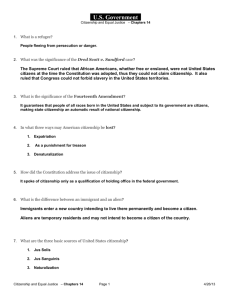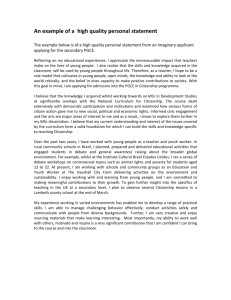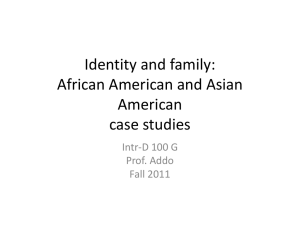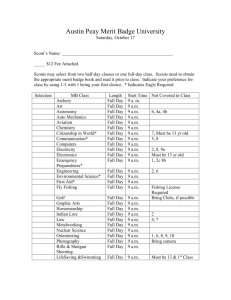here
advertisement
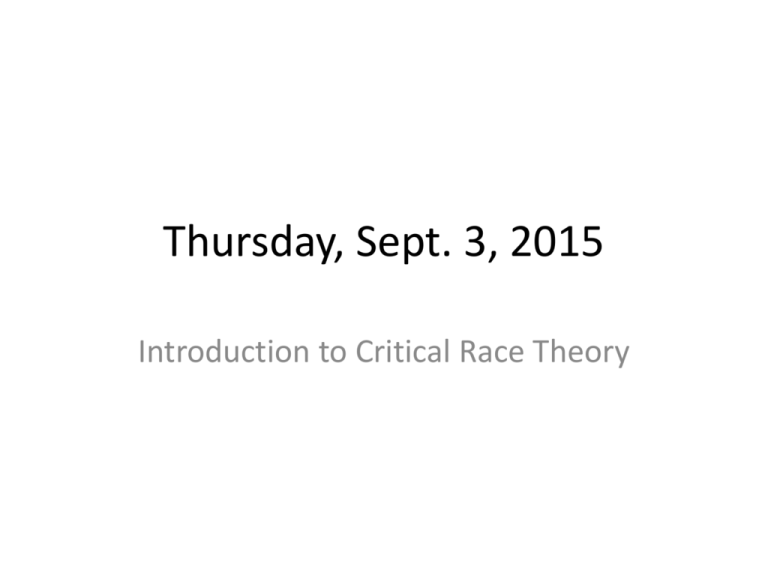
Thursday, Sept. 3, 2015 Introduction to Critical Race Theory Who’s White? • Source: Linda Gordon, “Who’s White?” New York Times, 25 March 2010 • 18th-century German scholars invented racial “science.” SCIENCE! • Dutchman Petrus Camper calculated the proportions and angles of the ideal face and skull, and produced a scale that awarded a perfect rating to the head of a Greek god and ranked Europeans as the runners-up, earning 80 out of 100 • Englishman Charles White collected skulls that he arranged from lowest to highest degree of perfection. • The modern concept of a “Caucasian” race came from Johann Friedrich Blumenbach of Göttingen (1752-1840). Switching from skulls to skin, he divided humans into five races by color — white, yellow, copper, tawny, and tawny-black to jet-black — but he ascribed these differences to climate. Influential to founders of U.S. like Thomas Jefferson. Eugenics — the practice of breeding humans to produce desired characteristics. Thirty U.S. states passed laws that encouraged such practices, like forced sterilization of the mentally ill. Especially targeted towards people of color. In 1965, 30% of the women in Puerto Rico (a U.S. commonwealth) had been sterilized through public health policies created by the U.S. • Laws against miscegenation (sexual mixing between races) – overturned in 1967 Virginia v. Loving • 1922 Cable Act – women were finally allowed their own citizenship status; no longer dependent upon husband’s automatically Who was considered white? • • • • Nordic peoples, the English (NOT the Irish) Eventually, Germans and some others… Religion-based: Catholics & Jews not white Italians, Jews, Irish NOT considered white during the periods in which they immigrated (mid-19th to early 20th c.) • When and how did they become “obviously” white people? Case Study: the United States • Citizenship tied to race; race tied to citizenship Case Study: the United States • Citizenship tied to race; race tied to citizenship • Naturalization Act of 1790 (jus soli or jus sanguinis) – free whites (men) Case Study: the United States • Citizenship tied to race; race tied to citizenship • Naturalization Act of 1790 (jus soli or jus sanguinis) – free whites (men) • 1870 – persons of African nativity or descent Case Study: the United States • Citizenship tied to race; race tied to citizenship • Naturalization Act of 1790 (jus soli or jus sanguinis) – free whites (men) • 1870 – persons of African nativity or descent • Petition to be white (why not black?) Case Study: the United States • Citizenship tied to race; race tied to citizenship • Naturalization Act of 1790 (jus soli or jus sanguinis) – free whites (men) • 1870 – persons of African nativity or descent • Petition to be white (why not black?) • Rationale: legal precedent, scientific evidence, or common sense Racial Prerequisite Cases • List of cases: http://academic.udayton.edu/race/01race/W hite05.htm For more, see Ian Haney Lopez’s book White By Law: The Legal Construction of Race Other racially restrictive laws • These laws also helped shape the idea that America was a “white”country: • 1875 Page Act • 1882 Chinese Exclusion Act • Alien Land Laws (limited who can own property to those eligible for citizenship) • Johnson-Reed Act (1924) – national origin quotas (no Asians allowed) Origins of Critical Race Theory • Also influenced by Cultural Studies approach: how do we know what we know? • 1970’s and 80’s: students and scholars frustrated with the Civil Rights Movement – too slow, not enough being done (reliance on changing the law to produce equality) • Began to question how the law may actually be producing and sustaining inequality What is Critical Race Theory? • Note use of the word “critical” What is Critical Race Theory? • Note use of the word “critical” • Other forms of “race theory”: phrenology, eugenics, biological determinism([all “science”-based), racial hygiene (“purity”) Keywords for Critical Race Theory • Race, racism, racialized, racialization, racial formation, white, whiteness, white privilege, white supremacy, black, blackness, Latino/a, Asian, Asian American, Native American, indigenous, First Peoples, Arab, Muslim, mestizo, hapa, mixed-race, people of color, structure, liberalism, capitalism, capital, identity, embodiment, material, the body, minoritized, minoritization Key Questions for CRT • What is race? How race is constituted legally, culturally, socially, economically, etc? Key Questions for CRT • What is race? How race is constituted legally, culturally, socially, economically, etc? • What are the origins and implications of the way we think about race? Key Questions for CRT • What is race? How race is constituted legally, culturally, socially, economically, etc? • What are the origins and implications of the way we think about race? • How does “race” mean different things in different contexts, times, and places? Key Questions for CRT • What is race? How race is constituted legally, culturally, socially, economically, etc? • What are the origins and implications of the way we think about race? • How does “race” mean different things in different contexts, times, and places? • How does race interact with other forms of identity and embodiment? Key Questions for CRT • What is race? How race is constituted legally, culturally, socially, economically, etc? • What are the origins and implications of the way we think about race? • How does “race” mean different things in different contexts, times, and places? • How does race interact with other forms of identity and embodiment? • What creates the conditions for inequality? Axioms (starting points) • Racism is not an event (or a feeling), it’s a structure. (Ex. Incident vs. environment) --How some people see racism: an incident in which someone says something racist. --How racism is experienced: a system/environment in which I am vulnerable to racism. Axioms (starting points) • Racism is not an event (or a feeling), it’s a structure. (Ex. Incident vs. environment) • Race is not biological; it is socially constructed, yet it is real (it is a fiction with material consequences). Axioms (starting points) • Racism is not an event (or a feeling), it’s a structure. • Race is not biological; it is socially constructed, yet it is real (it is a fiction with material consequences). • Whiteness as a form of property (the students in the doc who said “something was being taken away”; whites earn higher wages; people have petitioned to be white, etc.) Axioms (starting points) • Racism is not an event (or a feeling), it’s a structure. • Race is not biological; it is socially constructed, yet it is real (race is a fiction with material consequences). • Whiteness as a form of property • Race is “intersectional” – i.e., we can’t think about race without also thinking about gender, sexuality, class. To be “Asian” means something different if you’re a man or a woman; gay or straight, rich or poor, etc. Why ask these q’s? What’s at stake? • Social justice. Outcomes for health, wealth, academic achievement, upward mobility, all indexed by race (and class, too). Why ask these q’s? What’s at stake? • Social justice. Outcomes for health, wealth, academic achievement, upward mobility, all indexed by race (and class, too). • Ruth Wilson Gilmore defines racism as “the state-sanctioned or extra-legal production and exploitation of group-differentiated vulnerability to premature death” (Golden Gulag 28). [race is the production of differential outcomes] Bottom Line • Race appears to be a natural, “obvious” phenomenon, but it is not. Race is more than just ocular (i.e., what you see on the surface). • Race means different things in different places and times • Brazil: brancos (white), pardos (brown), pretos (black), amarelos (yellow), indigenous [vs. UK, China] • Across time: “Oriental,” “Asian,” “n*gger,” “Negro,” “colored,” “African American,” “black” • “people of color” Solutions? Rather than ignoring difference from whiteness, understand difference within humans and human history. Knowing LESS about something is never the solution.
